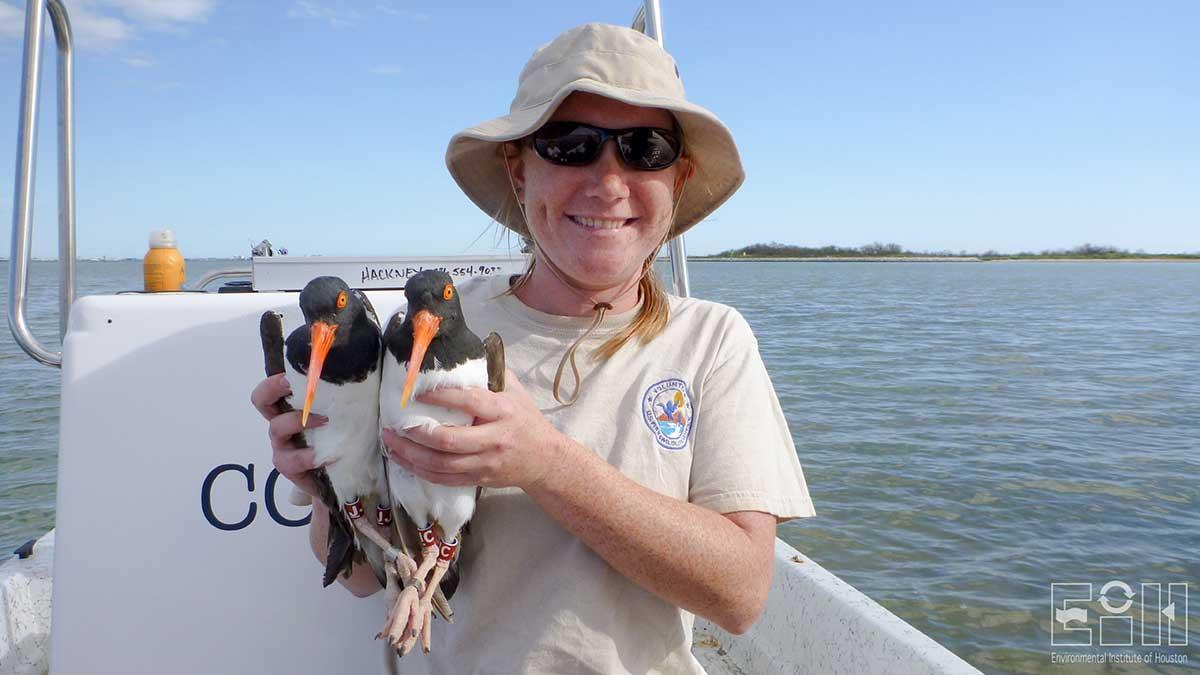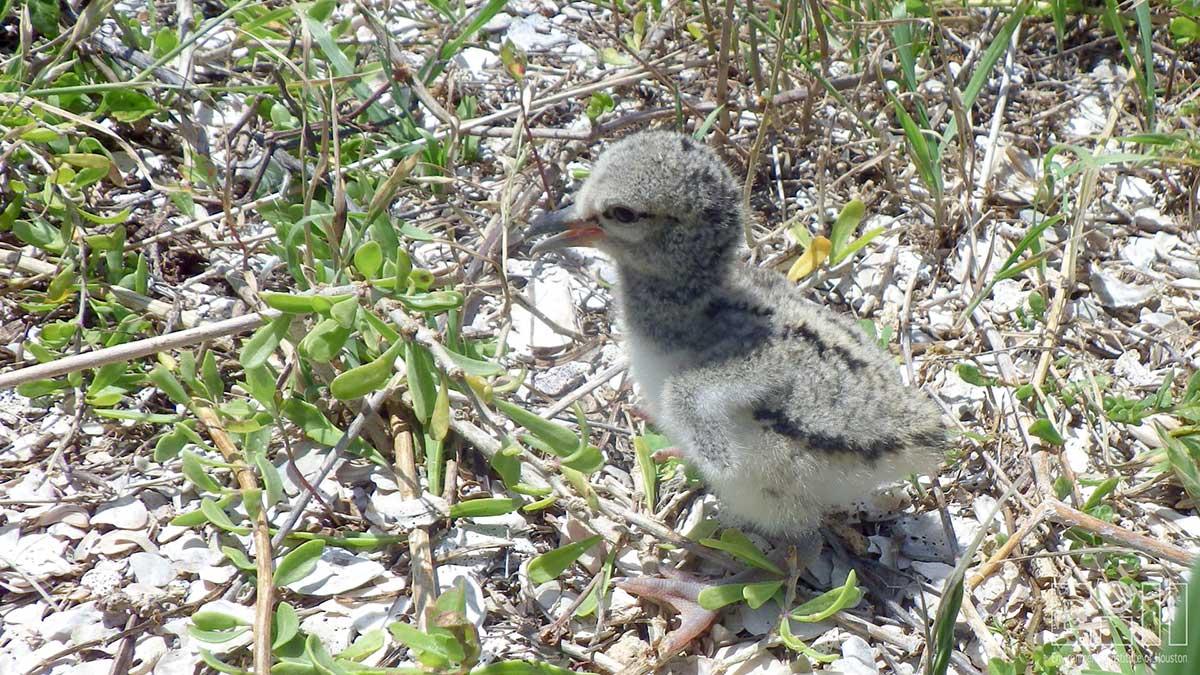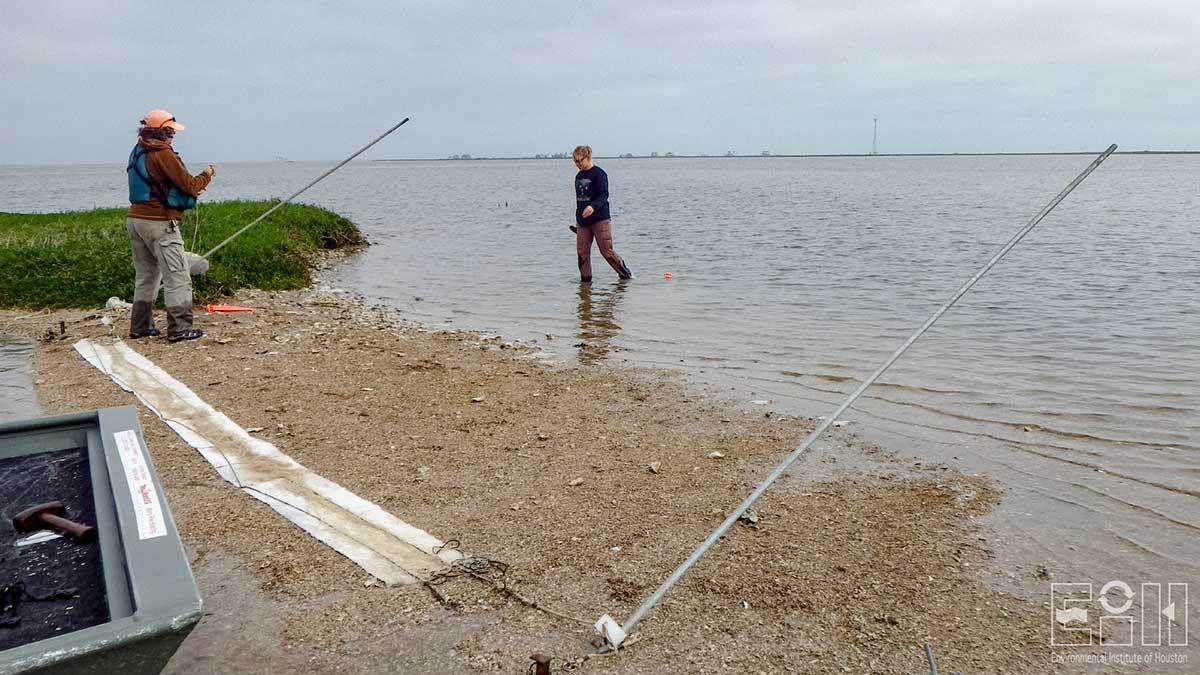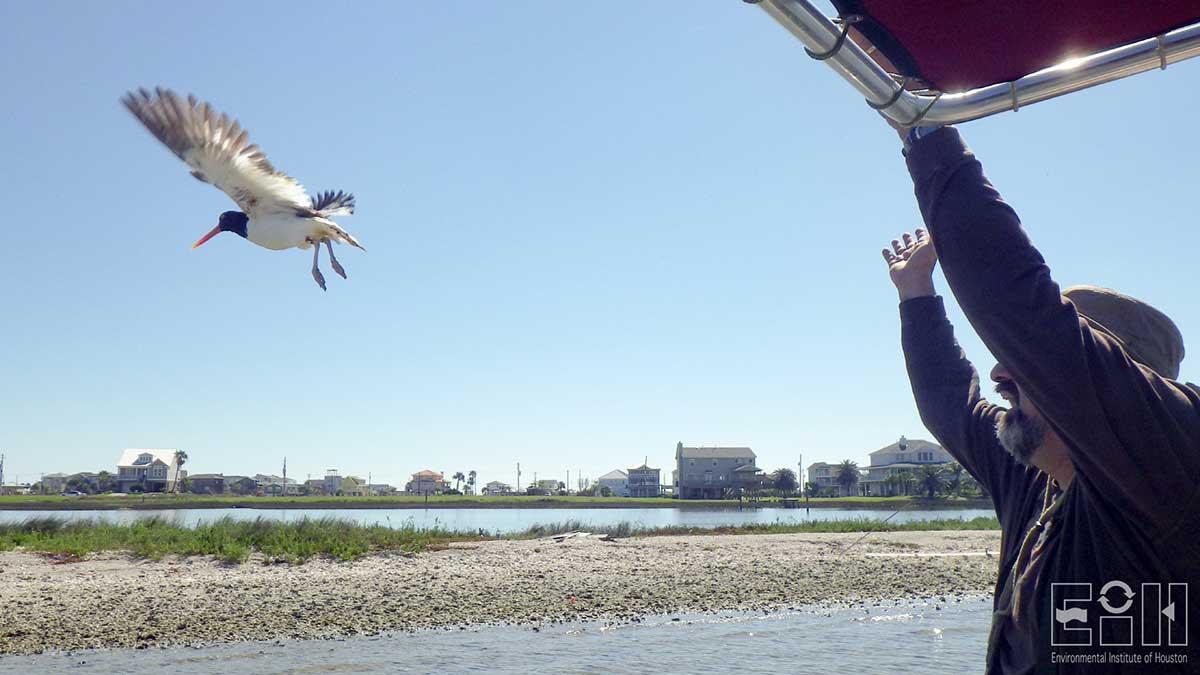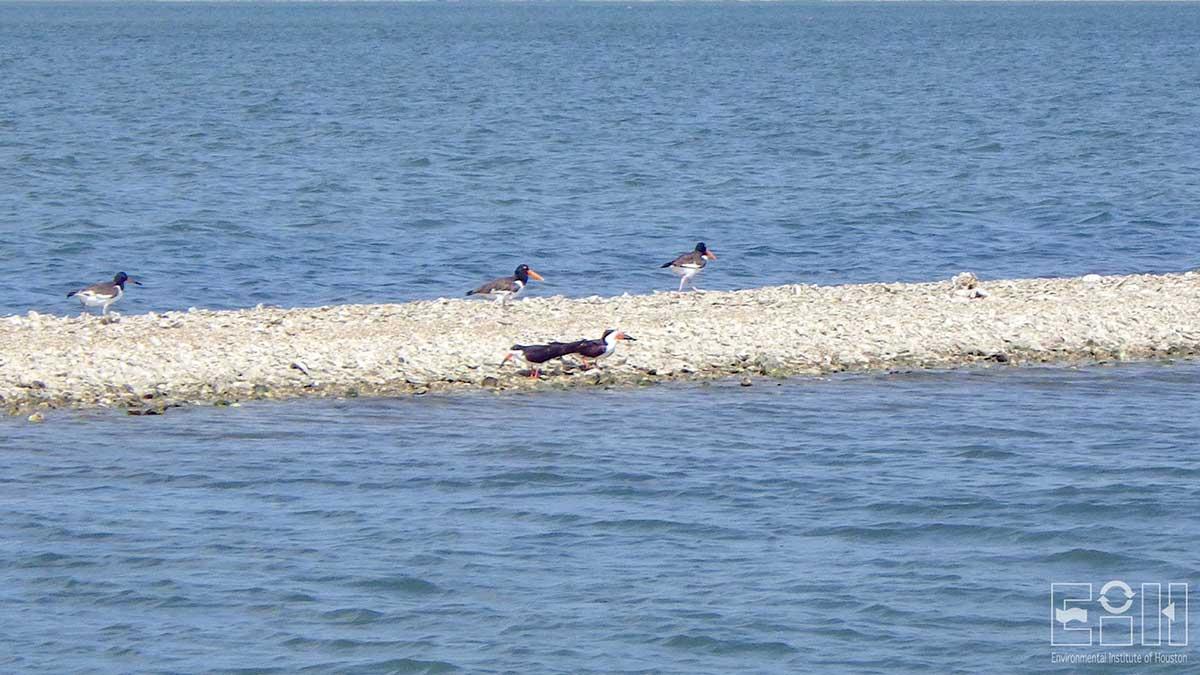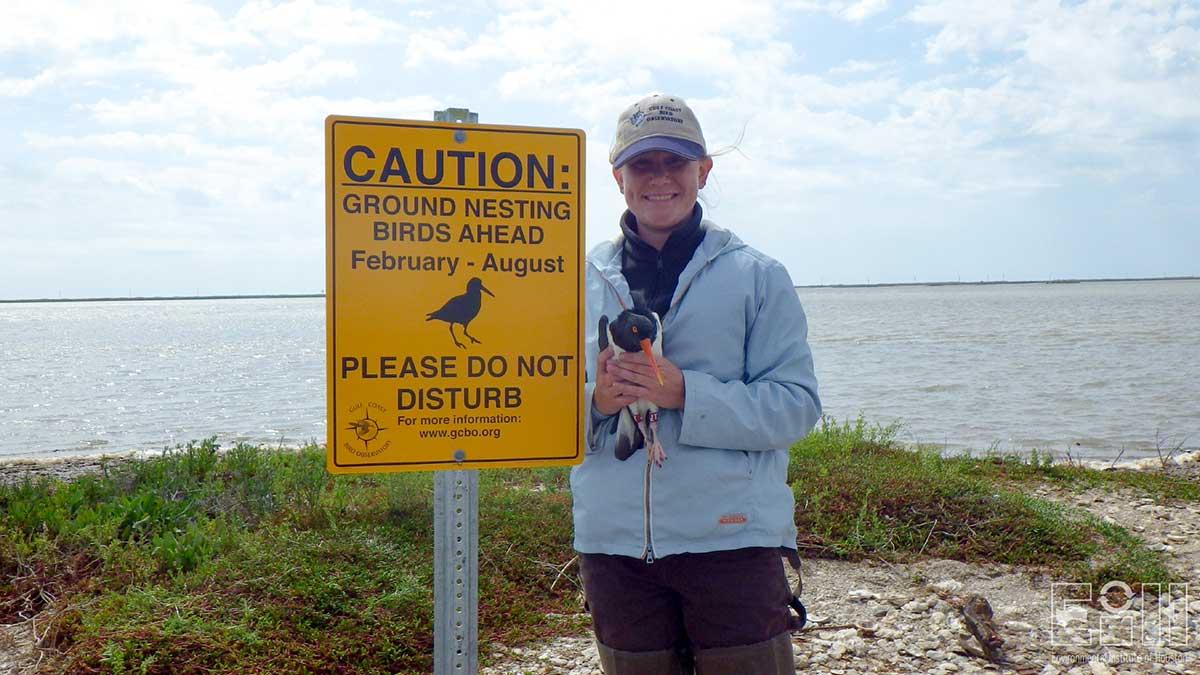
Texas American Oystercatcher Project
Purpose/Objectives
The objectives of this study were to 1) document the breeding parameters and movement patterns of the Western Gulf Coast American oystercatcher (Haematopus palliatus) population, 2) identify threats that may limit breeding success of individuals residing in the western limits of the species range, and 3) determine strategies to mitigate the identified threats.
Study Area
Galveston Bay, Texas
Project Period
2012 – 2014
Description
The Texas American Oystercatcher project was a joint effort between the Environmental Institute of Houston and the Gulf Coast Gulf Observatory (GCBO). A portion of the project's funding came from a grant awarded by the National Fish and Wildlife Federation to GCBO. EIH graduate student Amanda Anderson conducted research alongside Dr. Susan Heath of GCBO, who has been studying American oystercatcher (AMOY) productivity along the Texas coast since 2010.
The first objective of the study was to determine productivity by assessing reproductive success. Research took place during two breeding seasons which occurs from February to July in Galveston Bay, Bastrop Bay, and Drum Bay. We conducted nest surveys and nest monitoring of AMOY breeding pairs and their young. Adults and chicks were trapped and banded with unique two-character, color-coded bands and metal USGS bands.
The second objective of the study was to determine whether laughing gull colonies within AMOY nesting territory are affecting reproductive success. Anderson conducted time activity budgets during the incubation and chick rearing periods in order to determine if the presence of laughing gulls affect adult behavior and nesting success. Furthermore, all other disturbance events like nest depredation or weather were documented in an effort to identify other threats to productivity.
The third objective of the study was to determine if site and breeding pair fidelity affect productivity and the fledgling success of breeding pairs. We also aimed to categorize nesting and feeding territories in order to further explain differences in reproductive success among breeding pairs. Monthly surveys during the non-breeding season were conducted from September to January to address this research question.
Publications and Presentations
Anderson, A., Heath, S., and Guillen, G. 2016. A time activity budget of American oystercatchers (Haematopus palliatus) breeding in Texas. The Wilson Journal of Ornithology. 128(3):656-663.
Anderson, A.N. 2014. The factors affecting productivity and parental behavior of American oystercatchers in Texas. University of Houston-Clear Lake, Houston.
Anderson, A., Guillen, G., and Heath, S. 2014. A time activity budget for American oystercatchers (Haematopus palliatus) and the effect of laughing gulls on parental behavior. Meeting of the American Oystercatcher Working Group, Lake Jackson, TX. Presentation.
Anderson, A., Guillen, G., and Heath, S. 2014. A time activity budget for American oystercatchers (Haematopus palliatus) and the factors affecting parental behavior during the incubation and chick rearing periods. Gulf Estuarine Research Society 2014 Biennial Meeting, Port Aransas, TX. Presentation.
Anderson, A., Guillen, G., and Heath, S. 2014. The factors affecting nest and brood survival and chick body condition of American oystercatchers. Meeting of the American Oystercatcher Working Group, Lake Jackson, TX. Presentation.
Anderson, A. and Guillen, G. 2013. Measuring life history characteristics and effects of disturbance on the American oystercatcher (Haematopus palliatus) on the upper Texas coast. Meeting of the American Oystercatcher Working Group, Wrightsville Beach, NC.
The Oystercatcher Diaries 2014: Weeks 1 and 2
The 2014 field season has officially started.
The Oystercatcher Diaries 2014: Week 2 continued
What can happen in two days in the field? A lot it turns out.
The Oystercatcher Diaries 2014: Weeks 3 & 4
Despite bad weather, the team makes some observations and continues to find new oystercatcher
nests.
The Oystercatcher Diaries 2014: Week 5
The American oystercatcher team continues to find new nests.
The Oystercatcher Diaries 2014: Week 6
Week six was full of ups and downs as many of the weeks to come will be.
The Oystercatcher Diaries 2014: Week 7
Bad weather and high tides present difficulties for researchers and birds.
The Oystercatcher Diaries 2014: Week 8
A chance meeting with old friends proves that previously banded chicks are doing well.
The Oystercatcher Diaries 2014: Week 9
Type A or Type B? American oystercatchers have personalities too.
The Oystercatcher Diaries 2014: Week 10
The team bands the first chick of the season.
The Oystercatcher Diaries 2014: Week 11
Big news! Our first chick fledged!
The Oystercatcher Diaries 2014: Week 12
The nesting habits of American oystercatchers never cease to amaze!
The Oystercatcher Diaries 2014: Week 13
Sneaky oystercatchers, sneaky predators.
The Oystercatcher Diaries 2014: Week 14
A strong late season cold front roared through our area this week with heavy rain
and thunderstorms. Some nests survived while others didn't fare so well.
The Oystercatcher Diaries 2014: Week 15
Human disturbance and predation by mammals are two problems that plague nesting oystercatchers.
The Oystercatcher Diaries 2014: Week 16
It's hard work looking after two toddlers, especially when you are surrounded by voracious
chick eating machines!
The Oystercatcher Diaries 2014: Week 17
This week the team finds that there's a first time for everything as they discover
one pair's effort to raise a successful family. Plus, submit your entry for a fun
caption contest.
The Oystercatcher Diaries 2014: Week 18
What happens when an oystercatcher chick fledges? Researchers witness firsthand some
parent-chick interaction that may answer this question.
The Oystercatcher Diaries 2014: Week 19
This week the team is reminded why it's important to heed nesting site signs and what
happens when people don't.
The Oystercatcher Diaries 2014: Week 20
With only one nest remaining to hatch, the field season is winding down.
The Oystercatcher Diaries 2014: Week 21
There's never a dull moment when you are out banding chicks.
The Oystercatcher Diaries 2014: Week 22
The field season is quickly coming to an end, but chicks are still fledging.
The Oystercatcher Diaries 2014: Week 23 The Oystercatcher Diaries 2014: Week 23
Flat tires, siestas and private moments mark the end of the field season.







